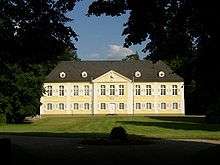Stutensee
| Stutensee | ||
|---|---|---|
 | ||
| ||
 Stutensee | ||
| Coordinates: 49°03′53″N 8°28′18″E / 49.06472°N 8.47167°ECoordinates: 49°03′53″N 8°28′18″E / 49.06472°N 8.47167°E | ||
| Country | Germany | |
| State | Baden-Württemberg | |
| Admin. region | Karlsruhe | |
| District | Karlsruhe | |
| Government | ||
| • Mayor | Klaus Demal | |
| Area | ||
| • Total | 45.67 km2 (17.63 sq mi) | |
| Elevation | 114 m (374 ft) | |
| Population (2017-12-31)[1] | ||
| • Total | 24,242 | |
| • Density | 530/km2 (1,400/sq mi) | |
| Time zone | CET/CEST (UTC+1/+2) | |
| Postal codes | 76288–76297 | |
| Dialling codes | 07244, 07249, 0721 | |
| Vehicle registration | KA | |
| Website |
www | |
Stutensee is a town in northern Karlsruhe district in Baden-Württemberg, Germany.


It was founded in 1975 by the voluntary connection of the four villages of Blankenloch with Büchig, Friedrichstal, Spöck and Staffort. In the meantime it has become a lively city with more than 23,000 inhabitants.
Castle of Stutensee
Castle of Stutensee is the geographic center and namesake of the city. It was built in 1749 by the margrave of Baden, by the 1,000-year-old oak trees. Today an institution of the Landeswohlfahrtsverband is located here.
Geography
The city is situated between Karlsruhe and Bruchsal in the Upper Rhine-region and its altitude is 114 m.
History
Stutensee was founded January 1, 1975 when the four villages of Blankenloch (with Büchig), Friedrichstal, Spöck and Staffort were combined into one municipality. All parts of the town are old villages. Spöck was first mentioned in official documents as Speccha in 865, Staffort 1110 as Stafphort, Blankenloch 1337 as Blankelach and Büchig 1373 as Buchech. Friedrichstal was founded in 1699. Huguenots fleeing religious persecution came from the north of France, and also by way of Belgium and Switzerland.
Notable people
- Werner Fischer, former President of the University of Applied Sciences in Karlsruhe
- Axel Fischer, member of the German parliament
Sport
One of the town's association football club FC Germania Friedrichstal, formed in 1913, experienced its greatest success in 2014 when it won promotion to the Oberliga Baden-Württemberg for the first time.
Literature
- Heinz Bender (1995) (in German), Vergangenheit und Zeitgeschehen: Eine Chronik. Blankenloch/Büchig/Schloss Stutensee, Stutensee: Gemeinde
- Konrad Dussel: Staffort 1110 bis 2010; Streifzüge durch 900 Jahre Geschichte; Verlag Regionalkultur Heidelberg, Ubstadt-Weiher, Basel 2010 ISBN 978-3-89735-622-1
- Wilhelm Hauck (1993) (in German), Staffort - Schloß und Dorf an der steten Furt. Geschichte und Geschichten, Stutensee: Gemeinde
- Artur Hauer (1965) (in German), Das Hardtdorf Spöck. Seine politische, kirchliche und wirtschaftliche Geschichte, Spöck: Bürgermeisteramt
- Dieter H. Hengst (2000) (in German), Die alten Straßen noch… Bildband „Alt Friedrichsthal“ (2. ed.), Friedrichstal: Heimat- und Hugenottenmuseum „Alt Friedrichsthal“
- Moritz Hecht (1895) (in German), Drei Dörfer der badischen Hardt. Eine wirtschaftliche und sociale Studie, Leipzig
- Hanna Heidt: Erinnerungen an die Vergangenheit. Eigenverlag, Schwanen Stutensee-Staffort 2003
- Pia Hendel (2006), Stadt Stutensee, ed. (in German), Stutensee - Bilder einer Stadt, Ubstadt-Weiher: verlag regionalkultur, ISBN 978-3-89735-430-2
- Heiner Joswig: Als unsere Kirche stehen blieb Stadt Stutensee 2004
- Manfred G. Raupp: Ortsfamilienbuch Staffort, Herausgeber Stadt Stutensee, Verlag Gesowip Basel 2010, ISBN 978-3-906129-64-8
- Walter August Scheidle (2001) (in German), Ortssippenbuch Blankenloch-Büchig und dem Stutensee - 1672 bis 1920, ISBN 3-00-008164-X
- the same: Ortssippenbuch Spöck / Baden 1667-1920, Band 124 der Badischen Ortssippenbücher Lahr-Dinglingen 2008 ISBN 978-3-00-024233-5
Gallery
| Wikimedia Commons has media related to Stutensee. |
- Kerns-Max-House at Blankenloch
- "Hermannshäusle" and the Protestant Church (Michaeliskirche) at Blankenloch
 Catholic Church at Blankenloch
Catholic Church at Blankenloch Old Schoolhouse at Blankenloch
Old Schoolhouse at Blankenloch Railway station at Blankenloch
Railway station at Blankenloch City Hall
City Hall- Protestant Church at Friedrichstal
- Protestant Church at Spöck
- Protestant Church at Staffort
- Timber framing houses at Staffort
References
- ↑ "Bevölkerung nach Nationalität und Geschlecht am 31. Dezember 2017". Statistisches Landesamt Baden-Württemberg (in German). 2018.
